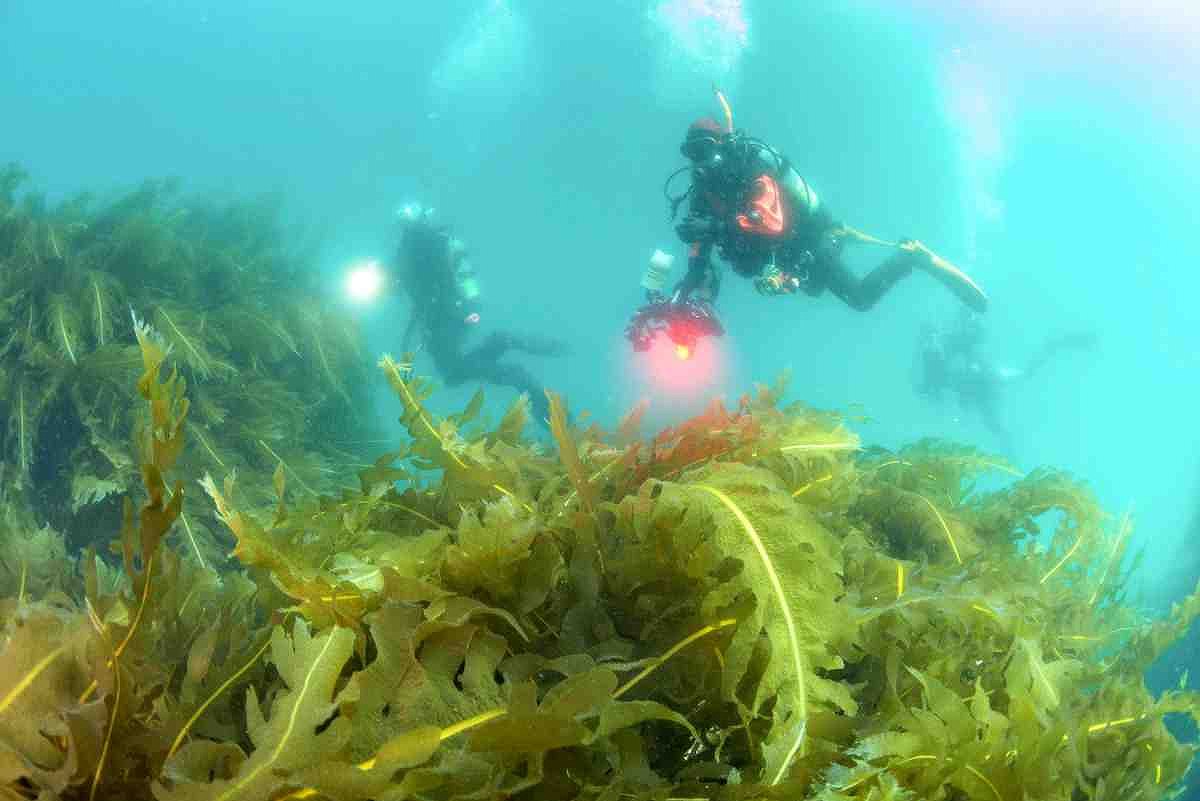Japan Plans to Subtract ‘Blue Carbon’ from CO2 Emissions; Seaweed Said to Lock Up Carbon for Longer than Land Plants

Seaweed covers rocks in the sea off Echizen, Fukui Prefecture, in April 2022.
17:23 JST, December 8, 2023
DUBAI — The government plans to subtract “blue carbon” when calculating Japan’s greenhouse gas emissions for annual reporting to the United Nations from next fiscal year. Blue carbon is carbon dioxide absorbed and stored by seaweed and seagrass.
At the 28th Conference of the Parties (COP28) to the U.N. Framework Convention on Climate Change now being held in the United Arab Emirates, Japan plans to promote blue carbon decarbonization measures by presenting examples such as the creation of seaweed beds in Japan.
Blue carbon was named by the U.N. Environment Programme (UNEP) in 2009 in reference to the blue ocean. In addition to seaweed and seagrass meadows, tidal marshes and mangrove forests are also recognized as blue carbon ecosystems.
Carbon absorbed and stored in forests and other green areas on land is called green carbon.
Japan and other major countries, which are required to report their domestic greenhouse gas emissions to the United Nations each year, are allowed to deduct the amount of CO2 absorbed by plants through photosynthesis.
Japan has set a target to reduce its net emissions, after subtracting absorption, to 46% below the level in fiscal 2013 by fiscal 2030, and to achieve net zero emissions by fiscal 2050.
Net domestic emissions in fiscal 2021 were 1.12 billion tons, up 2% from the previous year. Calculating this figure included subtracting 47.6 million tons for absorption, most of which came from forests.
Although there was no established method for calculating the amount of CO2 absorbed by seaweed and seagrass meadows, the government has devised a method by estimating the distribution of such meadows based on the topography and water temperature of coastal areas nationwide, based on satellite photos.
The government now expects to be able to subtract blue carbon from emissions for fiscal 2022, which will be reported in the next fiscal year.
According to estimates by the Port and Airport Research Institute and other organizations, blue carbon absorption in Japan ranges from 1.32 million to 4.04 million tons per year.
Seaweed and seagrass meadows in Japan account for about 1% of the country’s forest area. But as the amount of carbon newly sequestered by existing terrestrial forests is expected to decrease in the future as they age, blue carbon is expected to account for up to 12% of total carbon sequestration in 2030.
When trees die or forests burn, the carbon they previously absorbed is released into the atmosphere. Seaweed and seagrass, on the other hand, have the ability to store carbon for longer periods of time than forests. Even after they die, they remain on the ocean floor, where oxygen is scarce, without decomposing.
"Science & Nature" POPULAR ARTICLE
-

Genome Study Reveals Milestone in History of Cat Domestication
-

Big Leap in Quest to Get to Bottom of Climate Ice Mystery
-

Security Camera Footage Vulnerable to Outside Access; Investigation Finds 3,000 Pieces Exposed Online
-

Japan Set to Participate in EU’s R&D Framework, Aims to Boost Cooperation in Tech, Energy
-

Paws on Parade: Nairobi’s Dogs Dazzle at ‘Pawchella’
JN ACCESS RANKING
-

Tokyo Economic Security Forum to Hold Inaugural Meeting Amid Tense Global Environment
-

Keidanren Chairman Yoshinobu Tsutsui Visits Kashiwazaki-Kariwa Nuclear Power Plant; Inspects New Emergency Safety System
-

Imports of Rare Earths from China Facing Delays, May Be Caused by Deterioration of Japan-China Relations
-

University of Tokyo Professor Discusses Japanese Economic Security in Interview Ahead of Forum
-

Japan Pulls out of Vietnam Nuclear Project, Complicating Hanoi’s Power Plans

























